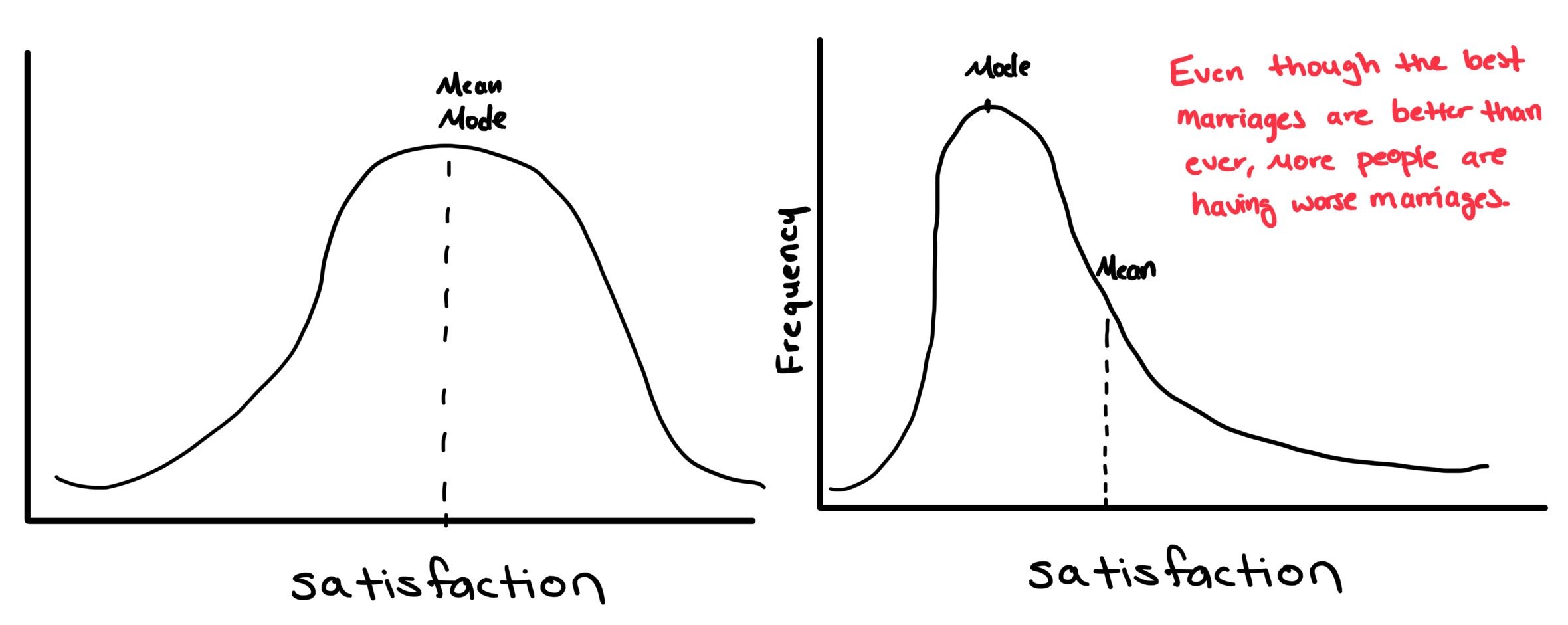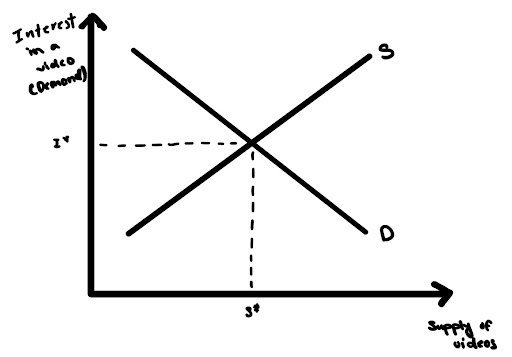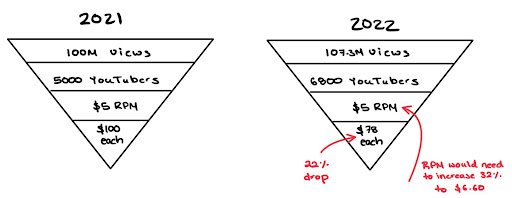Essay 2.3: The New American Dream
86% of young Americans want to become an influencer — so what does that mean for the creator middle class? You can watch the entire video above, as well as read the companion essay written by Mateo Price below.
When talking on the Colin and Samir Show, Jimmy Donaldson – aka MrBeast – had this to say about YouTube, the platform that made him a worldwide phenomenon:
“I think YouTube in 10 years is going to be bigger than we all imagined…I have no freaking doubt in my mind.”
The media landscape is changing at a rapid pace, and creators like MrBeast are redefining what’s possible. Look no further than his remake of the uber-popular Netflix show Squid Game, where he reportedly spent several weeks and millions of dollars on production…for a YouTube video.
The result? 235 million views, more than twice as many fans who tuned in to the Super Bowl.
Viewers are becoming conditioned to expect this bump in quality, too. When talking about the time and money he invests in his content, a creator with over 15 million subscribers recently told me, “One video for me in 2022 could have been six videos back in 2016.”
These examples don’t stand in isolation; rather, it’s indicative of a much larger trend. The quality of content on the platform continues to rise as creators such as MKBHD, Lilly Singh, and Yes Theory build out entire production studios and grow their teams.
Success stories across platforms have inspired millions. We’re already seeing more and more budding creators begin their journeys, and the next wave will likely be even greater. After all, in 2019, becoming a creator was named American kids’ number one dream job.
While this explosive growth is leading to user adoption in droves, for creators, the path to turning YouTube into a full-time career is a crowded one. But in order to formulate a modern-day roadmap, we first need to understand the world in which we’re playing.
Part I — Today’s YouTube Environment
The modern YouTube landscape is extremely bright. Millions of new creators join every year, billions of people around the world are on the platform and trillions of views are generated.
In 2021 alone, YouTube generated $30 billion, half of which went to creators. And as of December 2021, there are over 2.5 billion monthly active users.
A common mapping of the YouTube ecosystem and a ‘creator middle class’ might look like this:
Like a standard bell-curve, you’d have your average creators in the middle, the new players on the left, and the sliver of all-stars on the right. The distribution — from fun side-project to livable income to crushing it — is evenly distributed.
Unfortunately, this isn’t how it works. There are six million YouTube channels with over 1,000 subscribers, a key metric to establishing monetization. Of those, only 29,000 have more than 1,000,000 subscribers. A realistic map would look closer to this:
Many of today’s top-performing YouTubers make their living by amassing massive amounts of views and subscribers. This translates to higher AdSense revenues and better brand deals.
For new American YouTubers, we’re told the same game plan for success: achieve as many views and subscribers as possible, and then figure out what to do with them. Previously, this made sense as the number of new viewers was rising so quickly it didn’t matter if millions of new creators started producing content. Everyone was winning.
However, this pattern will likely change as YouTube focuses on global expansion. There will be more viewers than ever before, but they won’t be accessible to everyday American creators. Less views means less AdSense, and even today, 70 percent of creators say a dip in earnings from an algorithm change would have “serious effects'' on their life.
An odd but fitting analogy of where the ‘average’ American YouTube career might be heading toward is with marriage satisfaction. Because, in the last 30 years, the average marriage in the U.S. is getting worse, but the best marriages are better than ever before.
I foresee similar trends over the next decade for new American YouTubers. The best creators will continue breaking boundaries and reaching unprecedented levels of success, while the average creator will find it more difficult to develop a following monetizable off of AdSense alone.
Part II — The Globalization of YouTube
Given YouTube is not required to publicly disclose much information -- that’s reserved for their parent company, Google — it’s a challenge to find perfectly accurate data. That said, we have good estimates.
To start, YouTube already has almost 400 million daily users on its app alone. Approximately 122 million of those are from the United States (almost ⅓).
The first huge jump was the start of the pandemic.
Content consumption was at an all time high during the pandemic, and although those levels are likely to stay extremely high, it’s hard to imagine how it becomes magnitudes higher in America. Over the next three years, the number of monthly active users in the U.S. is expected to go from 204 million to approximately 219 million, an increase of approximately 7 percent.
Although 15 million is a large number, relative to YouTube’s global expansion plans, it’s peanuts. Today, YouTube has 2 billion monthly active users worldwide, and by 2025 they expect that number to be 2.85 billion.
The initial wave of growth for YouTube came in the United States. In fact, the number of YouTube channels with 10 million plus subscribers is overwhelmingly American. However, the next wave of YouTube’s growth will be global, and the next wave of stars will emerge from all over the world.
What does a huge rise in international reach signify? There will be an abundance of new opportunities for local creators to become stars, and for the existing top 1 percent of YouTubers to dub their content into other languages and expand their reach astronomically.
MrBeast alone already has more than 23 million subscribers to his dubbed Spanish channels in under two years. For creators who are already massive and can afford to dub their content, they will have a giant opportunity to reach new audiences.
The same isn’t true for the everyday American YouTuber. Subtitles won’t cut it. I’ve spoken with industry experts on dubbing technology, and it’s not expected to become largely accessible for years. With top creators dubbing their content and local creators making original content, it will be hard for the middle class English creators to penetrate the market.
Part III — A Race To The Bottom
So if YouTube is focusing its growth engine on international expansion, what happens to everyday American creators if our user growth slows?
We can turn to economics. On a given day, YouTube has a supply of new videos coming out, and a number of viewers interested in watching them.
As we mentioned before, it’s the number one dream job of kids to become creators (move over, astronauts) — 86 percent of kids in America want to become an influencer. Today, there are 51 million YouTube channels, which is a 36 percent increase over the last year. Additionally, there are a ton of TikTok creators trying to expand their presence onto YouTube, and many international creators today are attempting to make English channels given higher CPM levels.
So what happens when the supply of content rises, but demand doesn’t as quickly? Well, because there are more videos to choose from, people are less likely to see your video. The average success for a creator in terms of viewership is lower. Videos will need to stand out more.
We begin to enter a race to the bottom. In order to capture that audience with increased competition, we need bigger and better content to reach viewers. And as the ideas and content become bigger and better, the following videos will need to stand out even more, and then more…you get the idea.
We must remember the power laws at play. Social media platforms like YouTube care most about one thing: watch time. The longer you’re on the platform, the more ads they can sell.
And in 2022, new creators aren’t just competing against home-made videos from Smosh acting out skits with their mom’s old camcorder. Instead, we’re competing against MrBeast, Safiya Nygaard, Yes Theory, and the slew of other creators that have created entire production studios around themselves.
Many new creators today often try to recreate the content of their favorite creators. But giving away $100 to strangers doesn’t quite feel the same as Jimmy giving away $100,000. Vlogging your road trip doesn’t quite feel the same as Yes Theory traveling the world. Creators like Airrack produce videos that can be insanely dangerous and require the help of safety professionals.
Furthermore, many top creators have entire teams studying different video trends and analytics to make sure videos are as optimized as possible for a viewer to enjoy. Take it from me: I built a half-million dollar analytics agency exclusively serving top YouTubers on exactly this.
While that might be great for YouTube’s algorithms (more watch time!) and viewers (these videos are getting better and better!), it makes life tougher for the next wave of American creators.
One possible saving grace is if YouTube RPMs can rise fast enough to off-set these changes. Given a look at current data trends, we’d need a rise of 20-30 percent every year: possible, but difficult.
YouTube doesn’t have any data they publicly share on CPM/RPM levels, and even looking at my company’s own internal databases, it’s hard to forecast trends given the pandemic. It’ll go up, but the question is how quickly.
A hypothetical (emphasis on hypothetical). The numbers are made up, but the patterns aren’t. If the U.S. audience grows at current rates, and the creator pool increases at current rates, we’d need big RPM changes to keep people making the same amount of money on average.
The reality is, we’re competing against bigger ideas, larger budgets, and all-around higher scale. This doesn’t even include the fact that companies are now spending millions trying to crack algorithms and distribute that knowledge to their creator partners.
A rising tide lifts all boats, yes. But for everyday American creators, the rising tide will be much lower than it will for other parts of the world. And the number of boats is going to get quite crowded.
Part IV — Can A Creator “Middle Class” Exist?
Today, there’s a fundamental shift in the perspective we must adopt in regards to launching a career as a creator. For most up-and-comers, content is no longer the end product – creators need to diversify their revenue streams and not be solely reliant on algorithms that may not have their best interest in mind.
Instead, content should be seen as marketing towards other revenue streams. For some, that’s brand deals, which is essentially treating your audience as the product. For others, it’s merch and products that go beyond slapping a crude logo on a t-shirt. Engaging superfans. Crypto. Launching a podcast. Doing live events. Building courses. Live shopping (soon).
More and more opportunities exist for creators to monetize themselves beyond just AdSense. On a macro level, the way we interact with content is quickly becoming the future of e-commerce, and, in turn, commerce.
Take Madeline Ronzoni, aka @happy.rugs, for example. While having 600k+ followers on TikTok and 2k subscribers on YouTube are impressive figures on their own, given ever-decreasing creator fund, someone like Madeline probably can't launch a career off of viewership alone.
Madeline Ronzoni, aka @happy.rugs
No, her content in turn became marketing for her custom rugs, a business regularly generating 5 figures in revenue. And by surviving in the game long enough, iterating and tailoring her content to match her audience, she grew enough of a reputation that Nike came calling for an Air Max Day partnership.
As a new or aspiring creator – especially for American ones – the winning strategy will be less about focusing solely on views and subscriber counts to up your AdSense. To be fair, there’s always going to be room for the next crazy YouTube blow-up (see: Matthew Beem in 2021; Airrack in 2020). But that’s losing sight of the forest from the trees.
Instead, the path to success will be about finding and owning your specific niche on YouTube, and owning that direct relationship with your audience to the point where they’ll follow you and wherever your journey is regardless of a singular platform.
While the landscape might be daunting, the opportunities to build multi-faceted businesses are endless, which makes it an exciting time for the next generation of entrepreneurs.
Coverage from Creator Mag.2 continues on! Plus, follow along with our video essays by subscribing to our channel.













